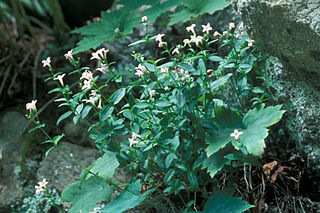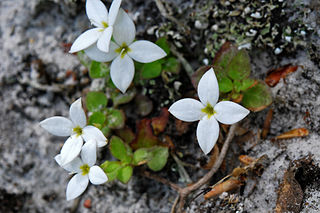
Houstonia caerulea, commonly known as azure bluet, Quaker ladies, or bluets, is a perennial species in the family Rubiaceae. It is native to eastern Canada and the eastern United States. It is found in a variety of habitats such as cliffs, alpine zones, forests, meadows and shores of rivers or lakes.
Bluet or bluets may refer to:

Houstonia (bluet) is a genus of plants in the family Rubiaceae. Many species were formerly classified, along with other genera since segregated elsewhere, in a more inclusive genus Hedyotis.

Houstonia longifolia, commonly known as long-leaved bluet or longleaf summer bluet, is a perennial plant in the family Rubiaceae. It can be found throughout most of the Eastern United States and Canada. It has been reported from every state east of the Mississippi River except Delaware, plus North Dakota, Minnesota, Missouri, Arkansas and Oklahoma, with isolated populations in Kansas and Texas. Also, all Canadian provinces from Quebec to Alberta. It prefers upland woods in poor, dry, often sandy soil.

Houstonia pusilla is a plant in the family Rubiaceae native to the United States and common in the southeastern and central parts of the country, from Texas to Florida north to Long Island and South Dakota, plus an isolated population in Pima County, Arizona.

Houstonia purpurea is a species of flowering plant in the coffee family known by the common names Venus's pride, woodland bluet, and purple bluet. It is native to the eastern United States from eastern Texas and Oklahoma east to Florida and Pennsylvania, with scattered populations in Nebraska, Iowa, Michigan, New York State and New England.
Physostegia correllii is a species of flowering plant in the mint family known by the common name Correll's false dragonhead. It is native to northern Mexico, as well as Texas and Louisiana in the United States. Most occurrences are historical and have not been seen recently. Today it is known from one location in Travis County, Texas, and two or three locations in Louisiana, and its current distribution in Mexico is unknown.

Houstonia procumbens, the roundleaf bluet, is a perennial species in the family Rubiaceae. It is native to the southeastern United States: Louisiana, Mississippi, Alabama, Georgia, Florida and South Carolina. Its native habitats include disturbed sites, and moist, open, sandy areas. Flowers bloom March to October.
Houstonia ouachitana, the Ouachita bluet, is a species of plants in the coffee family. It is endemic to the Ouachita Mountains of Arkansas and Oklahoma. It is an herb up to 20 cm tall, with lanceloate basal leaves and narrowly linear cauline leaves.
Houstonia croftiae, the South Texas bluet or Croft's bluet, is a species of plants in the family Rubiaceae. It is known only from 9 counties in southern Texas: Hidalgo, Starr, Zapata, Webb, La Salle, Duval, Jim Wells, Refugio and San Patricio).
Houstonia acerosa, the New Mexico bluet or needleleaf bluet, is a plant species native to Chihuahua, Coahuila, Nuevo León, Tamaulipas, San Luis Potosí, Texas and New Mexico.
Houstonia palmeri, the Saltillo bluet, is a plant species in the family Rubiaceae, native to the Mexican states of Coahuila and Nuevo León.

Houstonia humifusa, commonly called matted bluet, is a plant species in the coffee family (Rubiaceae). It is native to the United States, where it is found in Texas, Oklahoma, and New Mexico. It is typically found in sandy areas, or sometimes over gypsum.

Houstonia micrantha, the southern bluet, is a plant species in the coffee family.
Houstonia parviflora, the few-flowered bluet or Greenman's bluet, is a plant species in the Rubiaceae, found only in south-central Texas.
Houstonia rosea, the rose bluet, is a North American plant species in the coffee family. It is a tiny plant only a few centimeters tall, with pink flowers. It is native to the south-central United States: Texas, Oklahoma, Arkansas, Louisiana, Mississippi, Alabama and southern Missouri.
Houstonia rubra, the red bluet, is a plant species in the Rubiaceae. It is a small herb with red to reddish-purple flowers, native to the southwestern United States and northern and central Mexico: Coahuila, Nuevo León, Hidalgo, Zacatecas, Guanajuato, Puebla, Sonora, Durango, Chihuahua, Arizona, New Mexico, southeastern Utah and western Texas.

Houstonia serpyllifolia, commonly called thymeleaf bluet, creeping bluet, mountain bluet, Appalachian bluet or Michaux's bluets is a species of plant in the coffee family (Rubiaceae). It is native to the eastern United States, where it is found in the central and southern Appalachian Mountains. It has been documented in the states of Pennsylvania, Maryland, West Virginia, western Virginia, North Carolina, South Carolina, Kentucky, Tennessee, Ohio, and northeastern Georgia.
Houstonia subviscosa, the nodding bluet, is a plant species in the Rubiaceae. It is native to Texas.

Houstonia wrightii, the pygmy bluet, is a plant species in the Rubiaceae. It is native to the south-western United States and northern Mexico.









